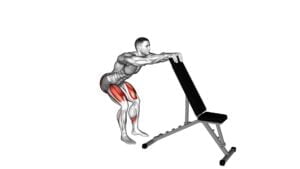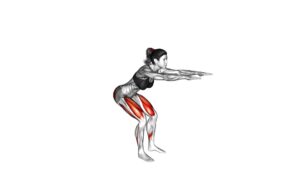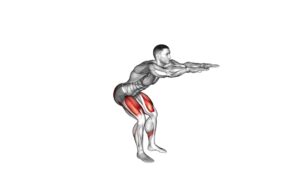Potty Squat With Support (Female) – Video Exercise Guide & Tips

Are you looking for an effective exercise to strengthen your lower body? Look no further than the Potty Squat With Support!
Watch This Exercise Video
In this video exercise guide, we'll show you the proper form and technique to maximize your results. With just a few simple modifications, you can tailor this exercise to fit your fitness level.
Say goodbye to common mistakes and hello to a stronger, firmer lower body.
Let's get started!
Key Takeaways
- The Potty Squat With Support activates key muscles in the body and strengthens lower body muscles.
- It improves stability, mobility, and aids in better digestion.
- The exercise promotes improved pelvic floor health.
- Proper form and technique, as well as modifications and variations, are important for a safe and effective workout.
Benefits of the Potty Squat With Support
Experience the numerous benefits of the Potty Squat With Support. This innovative device not only provides convenience but also offers several health benefits. By using the Potty Squat With Support, you activate key muscles in your body, leading to improved overall health and well-being.
One of the primary health benefits of using the Potty Squat With Support is muscle activation. When you squat, you engage your lower body muscles, including the glutes, quadriceps, and hamstrings. This activation helps strengthen these muscles, leading to improved stability and mobility in your everyday activities.
Additionally, the Potty Squat With Support can aid in better digestion. By assuming a squatting position, you align your colon more effectively, allowing for easier elimination of waste. This can help prevent issues such as constipation and hemorrhoids.
Furthermore, using the Potty Squat With Support can promote improved pelvic floor health. Squatting helps to open up the pelvic area, allowing for better blood flow and muscle relaxation. This can be particularly beneficial for women who've given birth or experience pelvic floor dysfunction.
Equipment Needed for the Potty Squat With Support
What equipment do you need to perform the Potty Squat With Support?
When it comes to this exercise, using the proper equipment is crucial to ensure safety and maximize the benefits of the workout. The importance of using the right support equipment can't be overstated. It provides stability and balance, allowing you to maintain proper form and prevent injuries during the exercise.
When choosing the right support equipment for potty squat exercises, there are a few key factors to consider.
First, ensure that the equipment is sturdy and stable, capable of supporting your body weight throughout the exercise. Look for equipment that's specifically designed for potty squat exercises, as it will provide the necessary support and functionality.
Additionally, consider the adjustability of the support equipment. Different individuals have different body types and flexibility levels, so having adjustable equipment will allow you to personalize the support according to your specific needs.
Another important factor to consider is comfort. Look for equipment that's ergonomically designed and provides cushioning or padding to reduce discomfort or strain on your joints.
Lastly, consider the space requirements for the support equipment. Make sure it fits well in your exercise area and allows you to move freely without any restrictions.
Proper Form and Technique for the Potty Squat With Support
To perform the Potty Squat With Support correctly, position yourself in front of the support equipment with your feet shoulder-width apart. This exercise is an effective way to strengthen your lower body muscles and improve your overall fitness. Squatting has numerous benefits, including building strength in your legs, hips, and core, improving balance and stability, and increasing flexibility. Here are some tips to ensure proper form and technique for the Potty Squat With Support.
First, make sure your feet are firmly planted on the ground and your weight is evenly distributed. Engage your core muscles by pulling your belly button in towards your spine. As you lower your body into a squat, keep your knees in line with your toes and your chest lifted. Aim to squat down as low as you can comfortably go, ideally until your thighs are parallel to the ground. Use the support equipment to help you maintain balance and stability throughout the movement.
Remember to breathe throughout the exercise, inhaling as you lower down and exhaling as you push back up. Start with a few repetitions and gradually increase the number as you become more comfortable and stronger. By practicing proper form and technique, you can maximize the benefits of squatting and achieve optimal results.
Modifications and Variations of the Potty Squat With Support
Continue improving your Potty Squat With Support by exploring modifications and variations that can challenge your muscles in different ways.
Potty squat modifications can help target specific muscle groups and add an extra level of difficulty to your workout routine. One modification you can try is the weighted potty squat. Instead of using just your body weight, hold a dumbbell or kettlebell at your chest or hang it between your legs to increase resistance. This will engage your muscles even more and help build strength and endurance.
Another variation to consider is the one-legged potty squat. This exercise focuses on balance and stability, as well as strengthening your legs and glutes. To perform a one-legged potty squat, lift one foot off the ground and extend it in front of you. Slowly lower yourself into a squat position, keeping your supporting knee in line with your toes. This variation requires more core engagement and can provide a greater challenge to your muscles.
Remember, proper technique variations are essential to ensure you're getting the most out of your Potty Squat With Support. Take your time to master the basic form before attempting any modifications or variations. It's important to maintain good posture, keep your knees aligned with your toes, and engage your core throughout the exercise.
By exploring different modifications and variations, you can continue to challenge your muscles and make progress in your Potty Squat With Support routine.
Now, let's move on to the next section where we'll discuss common mistakes to avoid during the potty squat with support.
Common Mistakes to Avoid During the Potty Squat With Support
To maximize the effectiveness of your Potty Squat With Support, it's important to be aware of common mistakes that you should avoid. By understanding these common mistakes and focusing on proper technique, you can ensure that you're getting the most out of your workout.
One common mistake to avoid isn't maintaining proper form throughout the exercise. It's important to keep your back straight and your chest lifted, while also engaging your core muscles. This will help to protect your lower back and prevent strain or injury.
Another mistake to avoid isn't using the support properly. The support should be positioned at a height that allows you to comfortably hold onto it while squatting. This will help to stabilize your body and prevent you from losing balance.
Additionally, be mindful of the depth of your squat. Going too low can put unnecessary strain on your knees, while not going low enough can limit the effectiveness of the exercise. Find a depth that feels challenging, but still allows you to maintain proper form.
Tips for Incorporating the Potty Squat With Support Into Your Workout Routine
To effectively incorporate the Potty Squat With Support into your workout routine, it's important to focus on proper form techniques.
This includes maintaining a straight back, engaging your core, and keeping your knees aligned with your toes.
Additionally, you can add variations and modifications to challenge different muscle groups and prevent plateauing.
Proper Form Techniques
To incorporate the Potty Squat With Support into your workout routine, focus on maintaining proper form techniques. By following these tips, you can ensure that you're performing the exercise correctly and reaping its benefits.
- Improve balance: Engage your core muscles and keep your weight centered over your feet throughout the movement. This will help you stay stable and prevent any wobbling or falling.
- Increase flexibility: As you squat down, aim to lower your hips as close to the ground as possible without discomfort. This will help to stretch and strengthen your hip and leg muscles, improving your overall flexibility.
- Keep your back straight: Avoid rounding your back during the squat. Instead, maintain a neutral spine by engaging your abdominal muscles and keeping your chest lifted.
- Use support: If you're new to the Potty Squat or have any difficulty with balance, use a sturdy object, such as a chair or wall, for support. This will provide stability and make it easier to perform the exercise correctly.
Workout Variations and Modifications
Incorporate different variations and modifications of the Potty Squat With Support into your workout routine to target various muscle groups and increase the intensity of your exercises. By making small changes to the exercise, you can challenge your body in new ways and prevent boredom.
One modification you can try is to add weights to your hands or wear ankle weights to increase resistance. This will help strengthen your muscles and make the exercise more challenging.
Another option is to perform the Potty Squat With Support on an unstable surface, such as a Bosu ball or a balance disc. This will engage your core muscles and improve your balance.
Additionally, you can incorporate alternative exercises, such as lunges or step-ups, to further work your lower body.
Remember to always listen to your body and modify the exercises as needed to avoid injury.
Frequently Asked Questions
How Long Should I Hold the Squat Position During the Potty Squat With Support Exercise?
When doing the potty squat with support exercise, it's important to focus on the squat duration and proper form.
The length of time you should hold the squat position may vary depending on your fitness level and comfort. It's recommended to start with shorter durations, around 10 to 20 seconds, and gradually increase as you build strength and flexibility.
Remember to maintain proper form throughout the exercise to maximize its benefits and prevent injury.
Can Men Also Benefit From Doing the Potty Squat With Support Exercise?
Yes, men can also benefit from doing the potty squat with support exercise. Gender inclusivity in fitness exercises is important for ensuring that everyone can improve their strength and mobility.
Incorporating functional movements like the potty squat helps to activate and strengthen the muscles in the lower body, improve balance and stability, and enhance overall fitness.
Is It Necessary to Warm up Before Performing the Potty Squat With Support Exercise?
It's important to warm up before performing the potty squat with support exercise. Warming up helps increase blood flow to your muscles, making them more flexible and less prone to injury. You can start with light cardio exercises like jogging or jumping jacks.
As for beginners, they may need some modifications for the potty squat with support exercise. They can try using a chair or a wall for added stability until they feel comfortable and confident in their form.
Can I Do the Potty Squat With Support Exercise if I Have Knee or Hip Problems?
If you have knee or hip problems, it's important to consider modifications for the potty squat with support exercise. Knee pain can be aggravated by this exercise, so it's best to avoid it if you have any discomfort.
However, if you still want to try it, make sure to use proper form and go at a pace that feels comfortable for you. For hip issues, you may need to adjust your stance or use additional support to avoid straining the hip joints.
How Often Should I Incorporate the Potty Squat With Support Exercise Into My Workout Routine for Optimal Results?
To get optimal results, it's important to incorporate the potty squat with support exercise into your workout routine regularly. The frequency of including this exercise will depend on your overall fitness goals and current fitness level. However, as a general guideline, aim to perform this exercise 2-3 times per week.
When doing the potty squat with support, try to hold the squat position for about 30 seconds to 1 minute for maximum benefit.
Conclusion
Incorporating the potty squat with support into your workout routine can provide numerous benefits for women. This exercise helps strengthen the lower body muscles, particularly the glutes, thighs, and core. It also helps improve balance and stability.
By following proper form and technique, avoiding common mistakes, and making necessary modifications, you can maximize the effectiveness of this exercise. With the right equipment and a consistent workout routine, the potty squat with support can be a valuable addition to your fitness regimen.

Author
Years ago, the spark of my life’s passion ignited in my mind the moment I stepped into the local gym for the first time. The inaugural bead of perspiration, the initial endeavor, the very first surge of endorphins, and a sense of pride that washed over me post-workout marked the beginning of my deep-seated interest in strength sports, fitness, and sports nutrition. This very curiosity blossomed rapidly into a profound fascination, propelling me to earn a Master’s degree in Physical Education from the Academy of Physical Education in Krakow, followed by a Sports Manager diploma from the Jagiellonian University. My journey of growth led me to gain more specialized qualifications, such as being a certified personal trainer with a focus on sports dietetics, a lifeguard, and an instructor for wellness and corrective gymnastics. Theoretical knowledge paired seamlessly with practical experience, reinforcing my belief that the transformation of individuals under my guidance was also a reflection of my personal growth. This belief holds true even today. Each day, I strive to push the boundaries and explore new realms. These realms gently elevate me to greater heights. The unique combination of passion for my field and the continuous quest for growth fuels my drive to break new ground.







